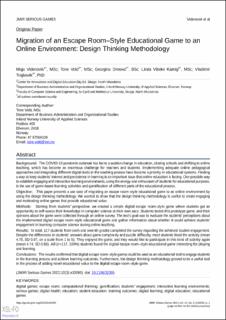| dc.description.abstract | The COVID-19 pandemic outbreak has led to a sudden change in education, closing schools and shifting to online teaching, which has become an enormous challenge for teachers and students. Implementing adequate online pedagogical approaches and integrating different digital tools in the teaching process have become a priority in educational systems. Finding a way to keep students' interest and persistence in learning is an important issue that online education is facing. One possible way to establish engaging and interactive learning environments, using the energy and enthusiasm of students for educational purposes, is the use of game-based learning activities and gamification of different parts of the educational process. This paper presents a use case of migrating an escape room–style educational game to an online environment by using the design thinking methodology. We wanted to show that the design thinking methodology is useful to create engaging and motivating online games that provide educational value. Starting from students’ perspective, we created a simple digital escape room–style game where students got an opportunity to self-assess their knowledge in computer science at their own pace. Students tested this prototype game, and their opinions about the game were collected through an online survey. The test's goal was to evaluate the students' perceptions about the implemented digital escape room–style educational game and gather information about whether it could achieve students' engagement in learning computer science during online teaching. In total, 117 students from sixth and seventh grades completed the survey regarding the achieved student engagement. Despite the differences in students’ answers about game complexity and puzzle difficulty, most students liked the activity (mean 4.75, SD 0.67, on a scale from 1 to 5). They enjoyed the game, and they would like to participate in this kind of activity again (mean 4.74, SD 0.68). All (n=117, 100%) students found the digital escape room–style educational game interesting for playing and learning. The results confirmed that digital escape room–style games could be used as an educational tool to engage students in the learning process and achieve learning outcomes. Furthermore, the design thinking methodology proved to be a useful tool in the process of adding novel educational value to the digital escape room–style game. | en_US |

